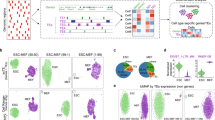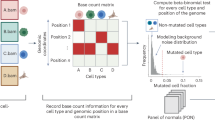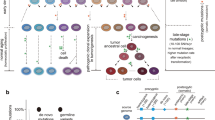Abstract
Cellular heterogeneity can emerge from the expression of only one parental allele. However, it has remained controversial whether, or to what degree, random monoallelic expression of autosomal genes (aRME) is mitotically inherited (clonal) or stochastic (dynamic) in somatic cells, particularly in vivo. Here we used allele-sensitive single-cell RNA–seq on clonal primary mouse fibroblasts and freshly isolated human CD8+ T cells to dissect clonal and dynamic monoallelic expression patterns. Dynamic aRME affected a considerable portion of the cells' transcriptomes, with levels dependent on the cells' transcriptional activity. Notably, clonal aRME was detected, but it was surprisingly scarce (<1% of genes) and mainly affected the most weakly expressed genes. Consequently, the overwhelming majority of aRME occurs transiently within individual cells, and patterns of aRME are thus primarily scattered throughout somatic cell populations rather than, as previously hypothesized, confined to patches of clonally related cells.
This is a preview of subscription content, access via your institution
Access options
Subscribe to this journal
Receive 12 print issues and online access
$209.00 per year
only $17.42 per issue
Buy this article
- Purchase on SpringerLink
- Instant access to full article PDF
Prices may be subject to local taxes which are calculated during checkout




Similar content being viewed by others
References
Elowitz, M.B., Levine, A.J., Siggia, E.D. & Swain, P.S. Stochastic gene expression in a single cell. Science 297, 1183–1186 (2002).
Suter, D.M. et al. Mammalian genes are transcribed with widely different bursting kinetics. Science 332, 472–474 (2011).
Cook, D.L., Gerber, A.N. & Tapscott, S.J. Modeling stochastic gene expression: implications for haploinsufficiency. Proc. Natl. Acad. Sci. USA 95, 15641–15646 (1998).
McAdams, H.H. & Arkin, A. Stochastic mechanisms in gene expression. Proc. Natl. Acad. Sci. USA 94, 814–819 (1997).
Raj, A., Rifkin, S.A., Andersen, E. & van Oudenaarden, A. Variability in gene expression underlies incomplete penetrance. Nature 463, 913–918 (2010).
Kaern, M., Elston, T.C., Blake, W.J. & Collins, J.J. Stochasticity in gene expression: from theories to phenotypes. Nat. Rev. Genet. 6, 451–464 (2005).
Eckersley-Maslin, M.A. & Spector, D.L. Random monoallelic expression: regulating gene expression one allele at a time. Trends Genet. 30, 237–244 (2014).
Chess, A. Mechanisms and consequences of widespread random monoallelic expression. Nat. Rev. Genet. 13, 421–428 (2012).
Reinius, B. & Sandberg, R. Random monoallelic expression of autosomal genes: stochastic transcription and allele-level regulation. Nat. Rev. Genet. 16, 653–664 (2015).
Gimelbrant, A., Hutchinson, J.N., Thompson, B.R. & Chess, A. Widespread monoallelic expression on human autosomes. Science 318, 1136–1140 (2007).
Zwemer, L.M. et al. Autosomal monoallelic expression in the mouse. Genome Biol. 13, R10 (2012).
Nag, A. et al. Chromatin signature of widespread monoallelic expression. eLife 2, e01256 (2013).
Savova, V. et al. Genes with monoallelic expression contribute disproportionately to genetic diversity in humans. Nat. Genet. 48, 231–237 (2016).
Eckersley-Maslin, M.A. et al. Random monoallelic gene expression increases upon embryonic stem cell differentiation. Dev. Cell 28, 351–365 (2014).
Gendrel, A.-V. et al. Developmental dynamics and disease potential of random monoallelic gene expression. Dev. Cell 28, 366–380 (2014).
Deng, Q., Ramsköld, D., Reinius, B. & Sandberg, R. Single-cell RNA–seq reveals dynamic, random monoallelic gene expression in mammalian cells. Science 343, 193–196 (2014).
Marinov, G.K. et al. From single-cell to cell-pool transcriptomes: stochasticity in gene expression and RNA splicing. Genome Res. 24, 496–510 (2014).
Borel, C. et al. Biased allelic expression in human primary fibroblast single cells. Am. J. Hum. Genet. 96, 70–80 (2015).
Picelli, S. et al. Smart-seq2 for sensitive full-length transcriptome profiling in single cells. Nat. Methods 10, 1096–1098 (2013).
Baker, D.E.C. et al. Adaptation to culture of human embryonic stem cells and oncogenesis in vivo. Nat. Biotechnol. 25, 207–215 (2007).
Pinter, S.F. et al. Allelic imbalance is a prevalent and tissue-specific feature of the mouse transcriptome. Genetics 200, 537–549 (2015).
Blom, K. et al. Temporal dynamics of the primary human T cell response to yellow fever virus 17D as it matures from an effector- to a memory-type response. J. Immunol. 190, 2150–2158 (2013).
Paul, W.E. Fundamental Immunology (Lippincott Williams & Wilkins, 2012).
Padovan-Merhar, O. et al. Single mammalian cells compensate for differences in cellular volume and DNA copy number through independent global transcriptional mechanisms. Mol. Cell 58, 339–352 (2015).
Sandberg, R. Entering the era of single-cell transcriptomics in biology and medicine. Nat. Methods 11, 22–24 (2014).
Miller, J.D. et al. Human effector and memory CD8+ T cell responses to smallpox and yellow fever vaccines. Immunity 28, 710–722 (2008).
Ohlsson, R. et al. Random monoallelic expression of the imprinted IGF2 and H19 genes in the absence of discriminative parental marks. Dev. Genes Evol. 209, 113–119 (1999).
Miyanari, Y. Torres-Padilla, M.-E. Control of ground-state pluripotency by allelic regulation of Nanog. Nature 483, 470–473 (2012).
Faddah, D.A. et al. Single-cell analysis reveals that expression of Nanog is biallelic and equally variable as that of other pluripotency factors in mouse ESCs. Cell Stem Cell 13, 23–29 (2013).
Filipczyk, A. et al. Biallelic expression of Nanog protein in mouse embryonic stem cells. Cell Stem Cell 13, 12–13 (2013).
Bix, M. & Locksley, R.M. Independent and epigenetic regulation of the interleukin-4 alleles in CD4+ T cells. Science 281, 1352–1354 (1998).
Nutt, S.L. et al. Independent regulation of the two Pax5 alleles during B-cell development. Nat. Genet. 21, 390–395 (1999).
Holländer, G.A. et al. Monoallelic expression of the interleukin-2 locus. Science 279, 2118–2121 (1998).
Savova, V., Patsenker, J., Vigneau, S. & Gimelbrant, A.A. dbMAE: the database of autosomal monoallelic expression. Nucleic Acids Res. 44, D753–D756 (2016).
Picelli, S. et al. Tn5 transposase and tagmentation procedures for massively-scaled sequencing projects. Genome Res. 24, 2033–2040 (2014).
Dobin, A. et al. STAR: ultrafast universal RNA–seq aligner. Bioinformatics 29, 15–21 (2013).
Jeffries, A.R. et al. Stochastic choice of allelic expression in human neural stem cells. Stem Cells 30, 1938–1947 (2012).
Li, S.M. et al. Transcriptome-wide survey of mouse CNS-derived cells reveals monoallelic expression within novel gene families. PLoS One 7, e31751 (2012).
Ramsköld, D., Wang, E.T., Burge, C.B. & Sandberg, R. An abundance of ubiquitously expressed genes revealed by tissue transcriptome sequence data. PLoS Comput. Biol. 5, e1000598 (2009).
Storvall, H., Ramsköld, D. & Sandberg, R. Efficient and comprehensive representation of uniqueness for next-generation sequencing by minimum unique length analyses. PLoS One 8, e53822 (2013).
Bolotin, D.A. et al. MiTCR: software for T-cell receptor sequencing data analysis. Nat. Methods 10, 813–814 (2013).
Zerbino, D.R. & Birney, E. Velvet: algorithms for de novo short read assembly using de Bruijn graphs. Genome Res. 18, 821–829 (2008).
Lefranc, M.-P. et al. IMGT, the international ImMunoGeneTics information system. Nucleic Acids Res. 37, D1006–D1012 (2009).
Huang, W., Sherman, B.T. & Lempicki, R.A. Bioinformatics enrichment tools: paths toward the comprehensive functional analysis of large gene lists. Nucleic Acids Res. 37, 1–13 (2009).
Huang, W., Sherman, B.T. & Lempicki, R.A. Systematic and integrative analysis of large gene lists using DAVID bioinformatics resources. Nat. Protoc. 4, 44–57 (2009).
Whitfield, M.L. et al. Identification of genes periodically expressed in the human cell cycle and their expression in tumors. Mol. Biol. Cell 13, 1977–2000 (2002).
Brennecke, P. et al. Accounting for technical noise in single-cell RNA–seq experiments. Nat. Methods 10, 1093–1095 (2013).
Acknowledgements
We thank D. Edsgärd for assistance in handling sequence data and members of the Sandberg laboratory for their input. J.M. was supported by a Human Frontiers Science Program Long-Term Fellowship (LT-000231/2011-l), and the work was supported by grants from the Swedish Research Council, the European Research Council (648842), the Swedish Foundation for Strategic Research, the Swedish Cancer Society, the Karolinska Institute, Tobias Stiftelsen, the Strategic Research Programme in Stem Cells and Regenerative Medicine at Karolinska Institutet (StratRegen), Knut och Alice Wallenbergs Stiftelse, and Torsten Söderbergs Stiftelse.
Author information
Authors and Affiliations
Contributions
B.R. designed mouse experiments, derived and sequenced the transcriptomes of mouse cells, performed computational experiments, prepared figures and tables, and wrote the manuscript. J.E.M. designed human experiments, performed FACS, sequenced the transcriptomes of human T cells, and analyzed TCR sequences. D.R. performed computational experiments and prepared figures. Q.D. designed mouse experiments and derived mouse cells. P.J. performed cell cycle classification. J.M. designed human experiments and performed FACS. J.F. designed human experiments. R.S. designed mouse experiments, supervised the work, and wrote the manuscript.
Corresponding author
Ethics declarations
Competing interests
The authors declare no competing financial interests.
Supplementary information
Supplementary Text and Figures
Supplementary Figures 1–22 and Supplementary Note. (PDF 10057 kb)
Supplementary Table 1
List of RNA–seq libraries. (XLSX 114 kb)
Supplementary Table 2
Genes escaping X inactivation in primary mouse fibroblasts. (XLSX 104 kb)
Supplementary Table 3
Imprinted genes detected by single-cell RNA-seq and bulk RNA-seq. (XLSX 42 kb)
Supplementary Table 4
Genes with clonal aRME in primary mouse fibroblasts. (XLSX 66 kb)
Supplementary Table 5
GO analysis of clonal aRME genes identified in mouse primary fibroblasts. (XLSX 59 kb)
Supplementary Table 6
Genes with clonal aRME in ex vivo–expanded human T cells. (XLSX 64 kb)
Supplementary Table 7
GO analysis of genes differentially expressed in fibroblasts with large and small diameters. (XLSX 98 kb)
Supplementary Table 8
GO analysis of genes positively correlated with the total amount of mRNA per fibroblast cell. (XLSX 219 kb)
Supplementary Table 9
GO analysis of genes negatively correlated with the total amount of mRNA per fibroblast cell. (XLSX 232 kb)
Supplementary Table 10
Genes differentially expressed in large and small fibroblasts. (XLSX 63 kb)
Supplementary Table 11
Gene expression level correlated with the total number of mRNA molecules per fibroblast cell. (XLSX 1527 kb)
Rights and permissions
About this article
Cite this article
Reinius, B., Mold, J., Ramsköld, D. et al. Analysis of allelic expression patterns in clonal somatic cells by single-cell RNA–seq. Nat Genet 48, 1430–1435 (2016). https://doi.org/10.1038/ng.3678
Received:
Accepted:
Published:
Issue Date:
DOI: https://doi.org/10.1038/ng.3678
This article is cited by
-
Single-nucleus transcriptomic analysis reveals the relationship between gene expression in oligodendrocyte lineage and major depressive disorder
Journal of Translational Medicine (2024)
-
LAST-seq: single-cell RNA sequencing by direct amplification of single-stranded RNA without prior reverse transcription and second-strand synthesis
Genome Biology (2023)
-
The transcriptional legacy of developmental stochasticity
Nature Communications (2023)
-
Elastic dosage compensation by X-chromosome upregulation
Nature Communications (2022)
-
BrewerIX enables allelic expression analysis of imprinted and X-linked genes from bulk and single-cell transcriptomes
Communications Biology (2022)



